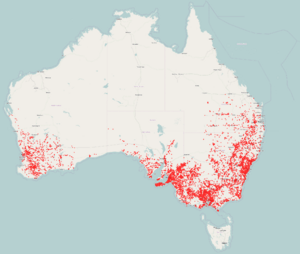Brown-headed honeyeater facts for kids
Quick facts for kids Brown-headed honeyeater |
|
|---|---|
 |
|
| In Victoria, Australia | |
| Conservation status | |
| Scientific classification | |
| Genus: |
Melithreptus
|
| Species: |
brevirostris
|
 |
|
| Distribution of the brown-headed honeyeater. Adapted from Atlas of Living Australia Data | |
The brown-headed honeyeater (Melithreptus brevirostris) is a type of passerine bird. It belongs to the Meliphagidae family.
This bird lives only in Australia. You can find it in temperate forests. It also lives in areas with Mediterranean-type shrubs.
Contents
About Its Name
The brown-headed honeyeater was first described in 1827. Two scientists, Vigors and Horsfield, gave it its name.
Its scientific name, brevirostris, comes from Latin. Brevis means 'short' and rostrum means 'beak'. So, it means 'short-beaked'.
There are five different types, or subspecies, of this bird. One type, called magnirostris, lives on Kangaroo Island. This one has a noticeably larger beak.
The brown-headed honeyeater is part of the Melithreptus group. Most birds in this group are similar in size. They usually have black heads, but this one has a brown head. Scientists have found that it is closely related to the black-chinned honeyeater. It is also related to the strong-billed honeyeater.
What It Looks Like
This is a small honeyeater, about 13 to 15 cm (5.2–6 in) long. Its back is olive-brown, and its belly is buff-colored.
Its head, neck, and throat are brown. It has a cream or orange patch of bare skin above its eye. There's also a dull white crescent shape on the back of its neck. Its legs and feet are orange.
The brown-headed honeyeater makes a scratchy sound. It sounds like chwik-chwik-chwik.
Where It Lives
The brown-headed honeyeater lives in many parts of Australia. You can find it in central-southern Queensland. It also lives across central and eastern New South Wales. However, it is mostly found west of the Great Dividing Range.
It is common across Victoria and into eastern South Australia. In South Australia, it lives in the Flinders Ranges. It is also found around the lower Murray River region. You can see it on the Eyre Peninsula too.
A different type of this bird, M. b. leucogenys, lives in south-western Western Australia.
What It Eats
This bird mainly eats insects. Like its relatives, the black-chinned and strong-billed honeyeaters, it finds food in a special way.
It probes into the bark of tree trunks and branches. This helps it find insects hidden there.
How It Raises Its Young
Brown-headed honeyeaters usually build nests between July and December. They might breed once or twice during this time.
Their nest is like a thick-walled bowl. It is made from grasses and small pieces of bark. The inside is lined with softer plant material. They hide their nests in the outer leaves of tall trees. These are usually eucalypt trees.
They lay two or three eggs. Each egg is about 16 x 13 mm in size. The eggs are shiny and buff-pink. They have a few red-brown spots, especially on the larger end.
See also
 In Spanish: Mielero cabecipardo para niños
In Spanish: Mielero cabecipardo para niños


